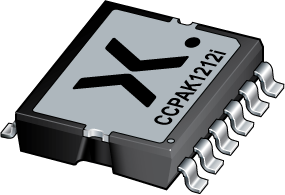
Register once, drag and drop ECAD models into your CAD tool and speed up your design.
Click here for more informationPSMN1R1-80CSF
NextPower 80 V, 1.16 mOhm, N-channel MOSFET in CCPAK1212i package
NextPower 80 V, standard level gate drive MOSFET. Qualified to 175 °C and recommended for high power industrial and consumer applications.
Features and benefits
Low Qrr for higher efficiency and lower spiking
400 Amps ID(max) continuous current rating
Low QG × RDSon FOM for high efficiency switching applications
Strong avalanche energy rating (Eas)
Avalanche rated and 100% tested
Ha-free and RoHS compliant CCPAK1212i package
Inverted package, suitable for top-side cooling
Applications
Battery protection
High power full and half-bridge configurations
BLDC motor control
OR-ing
Parametrics
| Type number | Package version | Package name | Product status | Channel type | Nr of transistors | VDS [max] (V) | RDSon [max] @ VGS = 10 V (mΩ) | Tj [max] (°C) | ID [max] (A) | QGD [typ] (nC) | QG(tot) [typ] @ VGS = 10 V (nC) | Ptot [max] (W) | Qr [typ] (nC) | VGSth [typ] (V) | Ciss [typ] (pF) | Coss [typ] (pF) | Release date |
|---|---|---|---|---|---|---|---|---|---|---|---|---|---|---|---|---|---|
| PSMN1R1-80CSF | SOT8005A | CCPAK1212i | Development | N | 1 | 80 | 1.16 | 175 | 400 | 34 | 206 | 1071 | 82 | 3 | 15363 | 4580 | 2024-05-06 |
Documentation (1)
| File name | Title | Type | Date |
|---|---|---|---|
| PSMN1R1-80CSF | NextPower 80 V, 1.16 mOhm, N-channel MOSFET in CCPAK1212i package | Data sheet | 2024-05-13 |
Support
If you are in need of design/technical support, let us know and fill in the answer form we'll get back to you shortly.
Models
No documents available
Ordering, pricing & availability
Sample
As a Nexperia customer you can order samples via our sales organization.
If you do not have a direct account with Nexperia our network of global and regional distributors is available and equipped to support you with Nexperia samples. Check out the list of official distributors.
How does it work?
The interactive datasheets are based on the Nexperia MOSFET precision electrothermal models. With our interactive datasheets you can simply specify your own conditions interactively. Start by changing the values of the conditions. You can do this by using the sliders in the condition fields. By dragging the sliders you will see how the MOSFET will perform at the new conditions set.
